Atrocities
by Mughal rulers, details of Hindu resistance, what our history textbooks miss
out whilst referring to Muslim invasions, reasons for Hindu defeat, status of
Hindu in an Islamic state and the truth about Akbar.
Part ONE
covers background and about the attackers, settlers
up to the start of the Mughal period and their atrocities.
NCERT and even All India Radio programs perpetuated the myth that medieval India under Islamic rule was a period of peace and amity between Hindus and Muslims. The strife was a creation of the British imperialists whose game now ‘Hindu communalists’ supposedly continue to play. The evidence would be, for example, Aurangzeb’s petty donations to a few Hindu temples patronized by some pet Hindu courtiers. Apologists go into raptures at molehills of munificence against mountains of malevolence going against all sense of proportion in judging a whole period of Indian history.
Unfortunately,
Muslim historians of medieval India gleefully painted their heroes in the
indelible dyes of Islamic ideology. They did not anticipate that the scales of
human values will one day judge the record of Islamic rulers. Though the
orthodox Muslim historians are honest while stating that the plundering
monarchs were following Islam, the Aligarh historians and their secularist
patrons try to give justifications by falsifying history.
The Provincial
Muslim Satraps in Gujarat, Bengal, or the South like Muzaffar Khan, Ahmad Shah, Mahmud
Begrha, Ilyas Shah, and the Bahmani Sultans were equally brutal as the Delhi
rulers showing intolerance. Their accounts are of persecuting Hindus and Jains,
converting or killing kings, destroying temples (Somnath, Rudramahalaya at
Sidhpur, Dwarka, Svayambhunath at Kathmandu, Bidar), attacking places
(Junagadh, Champaner, Nepal) and changing names of places. Junagadh and
Champaner became Mustafabad and Mahmudabad respectively.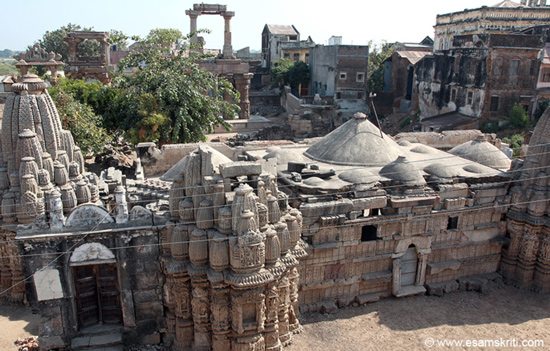 Rudramahalaya Sidhpur 2018
Rudramahalaya Sidhpur 2018
To
see pictures of Rudramahalaya Sidhpur, temple converted to mosque
Babur (1483-1530 CE) won Delhi after
defeating the Lodis and began the Mughal Empire. Tuzuk-i-Baburi proudly provides lurid details of
his repeated massacres of the infidels including raising high towers of Hindu
heads cut off during and after every battle. And he destroyed temples wherever
he saw them. Sher Shah Sur, after becoming
the emperor, at Raisen in 1543 (recorded in Zubdat-ul-Tawarikh), kills
Puranmal and 4000 of his men along with their wives and children despite
promising to let them go on the advice of Islamic scholars.baseline'> baseline'>Akbar (1542-1605 CE), Babur’s grandson, in 1568, ordered a massacre at Chittor after the fort had fallen. Akbar-Nama records the killing of 30,000 peasants with great zeal, something which even Alauddin Khilji had not done. The peasants watching and serving the warriors were acts of war. Akbar travelled then to Ajmer where he offered profuse thanks to Allah, the Prophet, and his patron saint, Moinuddin Chishti for following the true path.
Akbar’s son Jahangir (1569-1627 CE), an alcoholic and a
debauch, not much into the service of religion however encouraged conversions
to Islam by giving daily allowances to the converts. Tuzuk-i-Jahangiri describes his exploits. In the very
first year of his reign, he tortured Guru Arjun Dev to death to put a stop to
this dukan-e-batil (mart of falsehood). He later
destroyed the temple of Bhagwat at Ajmer. He later attacked Kangra slaughtering
cows, destroying temples, and raising a mosque. He hated the Jains in Gujarat.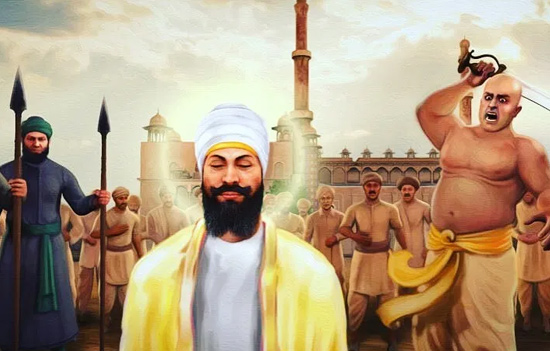 Execution of Guru Tegh Bahadur during Aurangzeb reign.
Execution of Guru Tegh Bahadur during Aurangzeb reign.
Shah Jahan, starting his reign in 1628 CE,
as recorded in Badshahnama, orders to bring down temples at Benares, the great stronghold of infidels. It talks of 76 temples destroyed in Benares (1633). In 1635, Shah Jahan’s soldiers forced some captured ladies of the royal Bundela family of Jujhar Singh into a Mughal harem. Shah Jahan, at Orchha, the capital of the Bundelas, personally demolished the lofty and massive temple of Bir Singh Dev and raised a mosque in its place. Two sons and one grandson of Jujhar Singh forcibly became Muslims. Another son, Udaybhan, and a minister, Shyam Dawa had death punishment for refusing to convert.
Aurangzeb (1618-1707 CE) completely
reversed the peace-for-all policy initiated in the later years of Akbar.
Aurangzeb had started his career as a but-shikan (iconoclast)
13 years before he ascended the throne at Delhi. According to Mirat-i-Ahmadi, he converted the temple of Chintaman at
Sarashpur (Gujarat) into a mosque named Quwwat-ul-Islam (might of Islam) in 1645. Three years after he became king (1658), he sent Mir Jumla on an expedition to Cooch Bihar who demolished all temples in that city and erected mosques. In 1665, he issued an order to the governor of Gujarat to destroy again any rebuilt temples previously destroyed.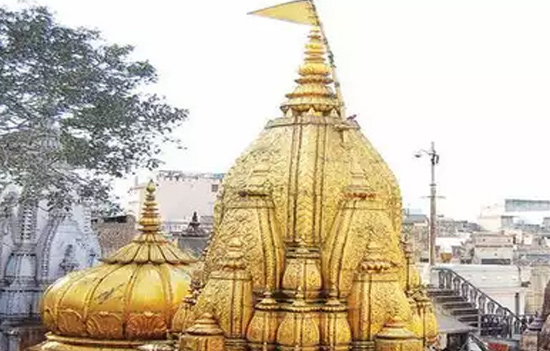 Kashi Vishwanath Mandir
Kashi Vishwanath Mandir
Maasir-i-Alamgiri records Aurangzeb’s orders in 1669 to destroy Brahmin schools and temples at Thatta, Multan, and Benares which had both Hindu and Muslim students learn the ‘wicked’ sciences. The government officers destroyed the temple of Bishnath at Benares. The same document records in 1670 the destruction of Dehra Keshav Rai temple at Mathura and laying the foundation of a mosque. The idols went as steps leading to Jahanara’s mosque. Mathura became Islamabad. Later Sitaramji temple at Soron, the shrine of Devi Patan at Gonda, temples around Ujjain, Cuttack (Orissa), Medinipur (Bengal) become objects of iconoclasm through official orders including the order not to rebuild them. Muraqat-i-Abul Hasan ordered
that reports of temple destruction to the court should be under the seal of
the qazis and attested by pious Shaikhs.
Several thousand Satnamis near Narnaul (1672) and Guru Tegh Bahadur (1675) underwent torturous deaths. Gurudwara destructions by Aurangzeb in Islamic zeal is well-known. Aurangzeb’s reign fills with iconoclasm at Khandela, Sanula, Jodhpur, Udaipur, Chittor, Mewar, Amber, Satara (Maharashtra), Hyderabad, Ellora, Bijapur, Trimbakeshwar, Narasinghpur and Pandharpur. He was responsible for the destruction of temples in thousands perhaps as the listing in his official documents appear unending. According to Kalimat-i-Tayyibat, Aurangzeb writes that ‘the demolition of a temple is possible at any
time, as it cannot walk away from its place’. He was quite annoyed by the solid strength of temples in Maharashtra. 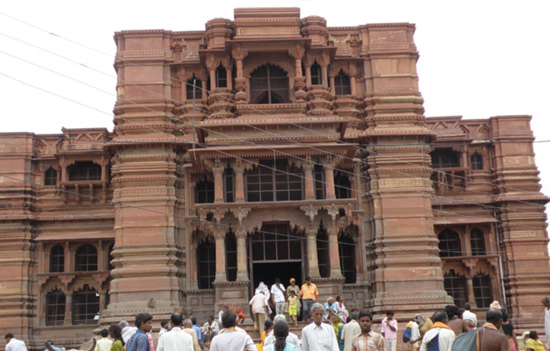 Govind Deo Temple Vrindavan, 4 out of 7 storeys destroyed on Aurangazeb orders.
Govind Deo Temple Vrindavan, 4 out of 7 storeys destroyed on Aurangazeb orders.
The
magnitude of crimes credited to Muslim monarchs by medieval Muslim historians
was beyond measure with only a few exceptions. The broad pattern is that of
a jihad in which the ghazis of
Islam invade infidel lands; massacre men, women, and children, particularly
Brahmins, after winning; capture the
survivors to be sold as slaves; plunder every place; demolish temples and build
mosques in their places, and defile idols which are flung into public squares
or made into steps leading to mosques.
It is a poor
apology to blame the Islamized Turks alone for being barbarous. Islamic
barbarism was in equal measure by all races and communities- the Arabs, the
Turks, the Persians, the Pathans, the Hindu converts. The conclusion is
inescapable: Islam brutalized all those who embraced it. The medieval India
conflict was not political as the NCERT guidelines want us to believe. The
Muslim rulers were convinced that they were waging a religious war against the
Hindu infidels.
The Myth of Muslim Empire
in India
The
apologists of Islam argue that if what the medieval historians wrote was true,
Hindus could not have survived as a majority. However, Hindus survived as a
majority because Hindu princes did not give up resistance. The popular version
of Indian history is a history of foreign invaders- the mythical Aryans, Iranians, Greeks, Parthians, Scythians,
Kushanas, Hunas, Arabs, Turks, Pathans, Mughals, Persians, Portuguese, Dutch,
French, and the British in regular succession. India appears to be a ‘No-Man’s Land’ where any armed person could walk in as a meek Hindu race bowed in deference.
Historians inform
the Indians, especially Muslims, that the conquest of India by Islam started
with Sindh by Muhammad bin Qasim in 712 CE, resumed by Mahmud Ghaznavi in 1000
CE, and completed by Muhammad Ghuri when he defeated the Chauhans of Ajmer in
the last decade of the 12th century. A disjointed six century period telescopes
into a single frame giving the picture of continuity- an exercise of
intellectual dishonesty.
The standard
textbooks narrate medieval Indian history from the 12th to 18th century by
the number of Muslim imperial dynasties ruling from Delhi- the Mamluks (Slaves), Khaljis, Tughlaqs, Sayyids, Lodis, Surs, and
the Mughals. The provincial Muslim dynasties with their seats at
Srinagar, Lahore, Multan, Thatta, Ahmedabad, Mandu, Burhanpur, Daulatabad,
Gulbarga, Bidar, Golconda, Bijapur, Madurai, Gaur, Jaunpur, and Lucknow fill
the gaps during periods of imperial decline. The British rulers become almost
temporary intruders who cheated Islam
of its Indian empire.
Hindu Resistance
Naturally,
in this version, the recurring Hindu resistance to Islamic invaders looks like
a series of sporadic revolts of a purely local character. The repeated Rajput resurgence in Rajasthan, Bundelkhand and
the Ganga-Yamuna Doab; the Hindu princes at Devagiri, Warangal, Dvarasamudra
and Madurai; the Vijayanagara Empire; the Marathas; the Ahoms of Assam; and the
Sikhs in Punjab reduce as ridiculous rebels disturbing the public peace by our
historians but always subdued in an enduring Muslim empire.
Our
history textbooks never highlight the most important points. Firstly, the Muslim invasions
were no walk-overs; secondly, the Turkish empire was short-lived; and thirdly,
the Mughal empire under Akbar was a joint venture with the Rajputs.
The Arabs first tried a naval invasion (634 to 637 CE) to Sindh; then a land route (650-711 CE); and finally, a land route via Makran in 712 CE. The Hindu princes repeatedly defeated them. Muhammad bin Qasim and his successors by the middle of the 8th century controlled only the highly garrisoned cities of Multan and Mansurah of Sindh. Within eight years of the Prophet’s death, the Arabs had conquered Persia, Syria, and Egypt. They conquered the Oxus and the Hindu Kush by 650 CE; North Africa between 640 and 709 CE; and Spain by 711 CE. But it took them 70 long years to secure their first foothold on the soil of India.
Two hundred years later, in 963 CE, Alptigin the Turk was
successful in seizing Ghazni. His successor Subuktigin seized Kabul from the
Hindu Shahiyas in 997 CE. His son, Mahmud Ghaznavi, led
many destructive expeditions into India between 1000 and 1027 CE. He seized the
Punjab west of the Ravi and the whole of Sindh. Though Mahmud went into the
heartland of Hindustan and won many victories, he
had to retreat every time in the face of Hindu counterattacks. The Jats almost killed him during his return from
Somnath in 1026 CE. The same Jats and the Gakkhars resisted the Muslim occupants of Sindh and Punjab after Mahmud’s death.
One hundred
and fifty years later, Muhammad Ghuri’s first
attempt towards Gujarat in 1178 CE met with disaster
at the hands of the Chaulukyas.
It was only in 1192 CE that he won his first victory against Hindus. Muhammad
Ghuri conquered the Punjab, Sindh, Delhi, and the Doab up to Kanauj. His
general Qutbuddin Aibak extended the conquest to Ajmer and
Ranthambhor in Rajasthan; Gwalior, Kalinjar, Mahoba and Khajuraho in
Bundelkhand; and, Katehar and Badaun beyond the Ganges. Meanwhile, Bakhtyar Khalji had conquered Bihar and Bengal
north and west of the Hooghly. He suffered a disastrous defeat when he tried to
advance into Assam.
But by the
time Muhammad Ghuri was assassinated by the Gakkhars in 1206 CE, and Aibak
assumed power, Kalinjar had been reconquered by the Chandellas, Ranthambhor had renounced vassalage to
Delhi, the Pratihars were back in
Gwalior, the Doab was up in arms under the Gahadvads, and
the Katehar Rajputs had reasserted their independence
beyond the Ganges. The Yadavbhatti Rajputs around Alwar had cut off the
imperial road to Ajmer. Aibak was not able to reconquer any of these
areas before his death in 1210 CE.
Aibak’s successor, Iltutmish, suffered several defeats
at the hands of the Guhilots of Nagda,
the Chauhans of Bundi, the Paramars of Malwa, and the Chandellas of
Bundelkhand. Beyond the Ganges, the Katehar Rajputs had consolidated
their hold which the Sultan could not shake. His grip on Ajmer had also started
slipping by the time he died in 1236 CE.
The Sultanate suffered a steep decline later but Balaban from 1246 CE prevented a dissolution. The Hindu Orissa seriously threatened the Muslim Bengal. A Muslim invasion of Assam ended in yet another disaster. Hindu chieftains, the Chandellas, and the Rajputs from Alwar started resisting Balban’s power in Bihar, Hansi, and even surrounding Delhi. Balban suffered several setbacks. The Sultanate once again diminished when Balban died in 1289 CE. Muslim authority throughout the 13th century was a military occupation of many important centres and hardly a systematic administration of the country at large.
Later, Alauddin Khalji could conquer Gujarat. Alauddin’s conquest of Chittor in 1303 CE was short-lived as the Sisodias retook it soon after his death. His own as well Malik Kafur’s expeditions against Devagiri, Warangal, Dvarasamudra, and Madurai were nothing more than raids because Hindu princes reasserted their independence in all these capitals soon after the invaders left. And the Khalji empire collapsed as soon as Alauddin died in 1316 CE.
Ghiyasuddin Tughlaq was successful in
conquering South and East Bengal. His son Jauna Khan (later Muhammad Tughlak) suffered defeat in 1321 CE when he tried to reconquer Warangal and had to mount another attack in 1323 CE before he could reduce it. But by 1326 CE, Prataparudra was back in power. In 1324 CE Jauna Khan had to retreat from Orissa. He later consolidated his hold over South India and transferred his capital to Devagiri to keep a close watch on Hindu resurrection in the South. But at the very start of his reign, Maharana Hammir of Mewar defeated him and released him only after he ceded all claims to Ajmer, Ranthambhor and Nagaur, besides payment of 50 lakhs of rupees as indemnity. He lost the empire south of the Vindhyas in his own lifetime, even as Delhi’s hold over large areas even in the North disappeared soon after his death in 1351 CE.
Firuz Shah Tughlaq was able to keep together
the rump for some time. It broke down completely after Timur’s invasion in 1399 CE. Meanwhile, the great Vijayanagara Empire had consolidated Hindu power south of the Krishna river. Rajput princes led by Mewar ruled Rajasthan and Orissa had fully recovered from the devastation of Firuz Shah Tughlaq’s raid.
The Sayyids (1414 CE) and the
later Lodis were hardly successful. Sikandar Lodi failed to subdue Gwalior, Rajasthan, and Baghelkhand. The Lodi ‘empire’ broke down under Ibrahim Lodi. By this time, Mewar under Rana Sanga had
emerged as the strongest state in North India. Orissa stood its ground against
Muslim Bengal to its north and the Bahmanis to its south. The power of
Vijayanagara attained its acme under Krishnadevaraya (1505-1530 CE).
Thus, during
the 14th and the 15th centuries, the Khalji empire rose
and fell during the brief period of twenty years (CE 1300-1320). The empire
of Muhammed bin Tughlaq broke up within a decade of
his accession (CE 1325), and before another decade was over, the Turkish empire
passed away forever. Thus, barring two short-lived
reigns, there was no Turkish empire in India. After nearly two
centuries and a half, the Mughals established a stable and durable empire in
the second half of the sixteenth century CE.
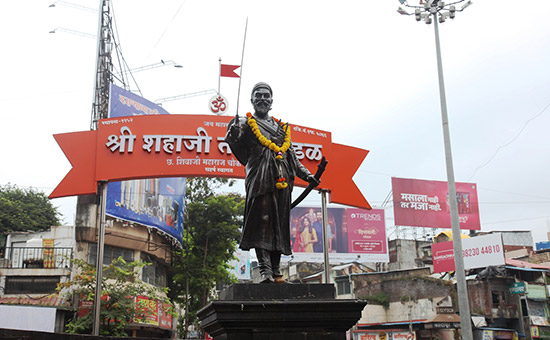 Shivaji
Maharaj Kolhapur.
Shivaji
Maharaj Kolhapur.
The Rise of the Marathas
Babur won some renowned victories but hardly established an empire. Humayun lost to Sher Shah Sur. Sher Shah, adding Ranthambhor and Ajmer, lasted only for a brief span of five years (1540-1545 CE). The Sur ‘empire’ became shambles soon after, so much so that the Hindu general Himu was able to crown himself as Hemachandra Vikramaditya at Delhi in 1556 CE. The
Mughal empire of Akbar in 1556 CE proved more stable and endured for 150 years. But the credit goes to Akbar’s recognition of power realities and reconciliation with the Rajputs by suspension of several tenets of a typically Islamic state. It was the
Rajput generals and soldiers who won many of the victories for which the
Mughals took credit. Mewar kept aloft the flag of
Hindu defiance throughout the period of effective Mughal rule.
The Mughal empire started breaking up very fast when Aurangzeb reversed Akbar’s policy of accommodating the Hindus and tried to re-establish a truly Islamic state based on terror and oppression. Rajasthan and Bundelkhand reasserted their independence during his lifetime. So did the Jats around Bharatpur and Mathura. Hindu resurgence by Marathas shattered the Mughal empire within two decades of Aurangzeb’s death in 1707 CE. The provincial Muslim principalities at Bengal, Malwa, Gujarat, and the Bahmanis were constantly in battle with Hindus from Orissa, the Vijayanagara kings, and the Marathas.
Muslim
Empire in India, between the 12th to 18th centuries, is nothing more than a period of
long-drawn-out war between Hindu resistances against Muslim invaders. The rise of Shivaji finally defeated and dispersed the
worn-out enemy. Islam struggled for six centuries to conquer India for good but
failed in the final round in the face of stiff and continued Hindu resistance.
One historian mourns that the invincible armada of Hijaz
which had swept over so many seas and rivers met its watery grave in the Ganges.
Hindus have survived as a majority in their motherland not because Islam spared
any effort to conquer but because it met more than its equal in Hindu tenacity
for freedom.
The
effective political power in India had already passed into the hands of the
Marathas, the Jats, and the Sikhs when the British started playing their
imperialist game. The Muslim principalities in Bengal, Avadh, South India,
Sindh, and Punjab were no match for the Hindu might that had resurged. The
Mughal emperor at Delhi by that time presented a picture of utter helplessness.
The custodians of Islam in India were repeatedly inviting Ahmad Shah Abdali
from across the border to come and rescue Islam.
The Determinants of Hindu
Defeats
Historians
place the root of Hindu failure in its social systems- particularly caste. The
illogical proposition reverses the chronological sequence. There is enough
evidence to show that the Hindu social system became moribund and the caste
system rigid only after Hindus lost political
power. In fact, this organic system saved the Hindus from extinction. Islam
engulfed Iran, Iraq, Syria, Egypt, and North Africa because they did not have a
solid social structure.
Hindu
failure looks like the failure of their art of warfare at first look but the
traditional Hindu warriors were as good as the Turks in terms of valour and
tenacity. At a second level, it could have been a political failure- a failure
of their state system. Larger Hindu states like the Shahiyas, the Chauhans, Chandellas, the Gahadvads, and the
Chaulukyas were far superior in financial means as well as
human power. The decentralised and democratic character of the Hindu state and
the paucity of central revenue under the Hindu system of public finance
prevented Hindu princes from maintaining standing armies on a permanent war
footing.
However,
there are stronger and deeper reasons for Hindu failure.
The first was a steep decline in the Hindu spiritual perception. The medieval saints and literature were harbingers of a casteless society unlike the previous ones focussing on all aspects of society including the dharmic need to fight enemies. However, the perspective became one of social indifference, not one of
social concern. The siddhas and the saints are indifferent not only
to varna and jati, but also to
the raja (royal duties) and the rashtra (state protection). Barring a few like
Samartha Ramdas, there are none to tell the princes to fight for their country.
Hindu saints of this period took at face value the professions of Islam that it
was a religion like one of their own.
The thinkers
and philosophers of this period debated in all subjects but none made a
systematic or serious study of Islam. Many of the Muslims were Hindu converts
forced or lured into Islam. Hindu society closed its doors on them permanently
and progressively alienating them. The Hindu thinkers and philosophers did not
work to win back the converts.
The second
was a failure of the Hindu cultural vision. There was a lapse of historical
memory and cultural tradition about the essential unity, integrity, and
sanctity of what the scriptures had clearly defined as Bharatavarsha. Hindus
failed to organise a collective effort to guard the frontiers of Bharatavarsha.
The third
factor, closely linked with the first two, was the failure of mental alertness
to what was happening in the world around. Hindu merchants, saints, and
Buddhist monks were still interacting with the lands invaded by Islam. But none
of them could see the storm that was rising on the sands of Arabia and warn the
Indian princes. Similarly, the Indian princes, though valiant, lacked
leadership, an outcome of an alert mind. They did not mend their statecraft,
system of revenue, military establishment, or the art of warfare in the face of
defeats.
Islam and
the Sufi saints settling in different parts of India, building mosques, and
converting people, before the Islamic armies came did provide an opportunity to
Hindus to be alert. Hindus paid the price of indifference. Moinuddin Chishti
sent out an invitation to an Islamic invader to come and kill the kafirs, desecrate their shrines, and plunder their
wealth. He was not the only one.
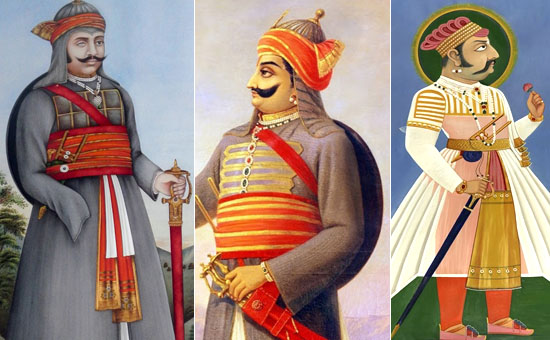 Rajput
Braves. Centre Maharana Pratap.
Rajput
Braves. Centre Maharana Pratap.
The Policies Not Pursued
What were
the policies not pursued? The first was a centre point for Hindu resistance
like in Mewar under Maharana Pratap, Vijayanagara, Maharashtra under Shivaji,
and Punjab under Banda Bahadur. But these centres crystallised too late. The
second was a forward policy taking the war into the heartland of Islam instead
of fighting to only defend their forts and citadels. Chalukyas or the Chauhans
did not pursue Ghuri; hence he came back another day. Marathas under Shivaji
and the Sikhs under Banda Bahadur demonstrated an effective forward policy but
again against an established Islamic state. The third was a policy of
reciprocity. Hindus never tried to cure Islam of its iconoclastic zeal as
reverse attacks on mosques was unthinkable for Hindu philosophy and this made
the invaders bold and ruthless.
Powered by petro-dollars, Islam is again dreaming of an empire in India on its claims of a ‘universal brotherhood’. Hindus, on the other hand, without learning anything, raise the slogan of sarva-dharma-samabhava. Hindu
secularists pervert the historical record to prove that Islam never intended
any harm to Hindus or Hinduism. A society without self-confidence and in daily
need of certificates of good conduct from its sworn enemies will not survive
any further attacks on the Hindus.
The Status of Hindus in
an Islamic State
The NCERT
guidelines say that historians cannot identify
Muslims as rulers and Hindus as subjects, and that medieval India under Muslim
rule was not a theocracy. The modern apologists of Islam accuse
the medieval historians of exaggeration; blame the Turks for barbarities
committed, and present as politically motivated the
dismal deeds which the medieval historians regarded as religiously inspired.
1. Nazim (The Life and Times of Sultan Mahmud of Ghazna) calls
his barbarities as legitimate warfare. He ransacked Indian
temples to secure the gold and precious stones apparently without religious
intentions. Nazim also writes that Hindu hatred for Islam was not because of
its plundering armies but due to fundamental and irreconcilable differences.
The hostile Brahmin (always available as a cause) opposed Islam for its
democratic principles likely to bring a social revolution and threaten his
exclusive status. A hatred of change inherent in the Hindu mind would be
another passive resistance to the progress of Islam. This is an example of a
narrative our secularists internalize and propagate.
Islamic laws
divide humans into mumins (believers)
and kafirs (non-believers). Jihad or a holy war calls upon the mumins to fight kafirs. Those
allowed to live should pay the jizyah or tax.
For those who do not accept conversion or jizyah, Jihad
involves massacre of males; enslavement of women and children; plunder of
movable properties; expropriation of lands; destruction of places of worship
and scriptures; and killing of priests.
Those who
agree to pay jizyah are zimmis, allowed to work for the Islamic State,
under many disabilities:
1. Not to build any new places of
worship or repair any old destroyed places.
2. To entertain for three days
any Muslim who wants to stay in their homes, and for a longer period if the
Muslim falls ill.
3. Not harbour any hostility
towards the Islamic state.
4. To show respect towards every
Muslim allowing them to participate in their private meetings.
5. Not to name themselves or
dress themselves as Muslims do.
6. Not to ride horses with saddle
and bridle, not to possess arms, not to wear signet rings, not to sell or drink
liquor openly.
7. To wear a distinctive differentiating
dress that shows their inferior status.
8. Not to propagate their customs
amongst the Muslims.
9. Not to build their houses in
the neighbourhood of Muslim.
10. Not to bring their dead near
the graveyards of the Muslims.
11. Not to observe their
religious practices publicly, or mourn their dead loudly.
12. Not to buy Muslim slaves.
The laws
prescribe the death penalty for those questioning the exclusive claim of Islam
as the only true religion, and of Muhammad as the last prophet; trying to revert to their original
faith, and marry Muslim women without converting first. Non-Muslims had
discrimination against in matters of testimony in law courts, taxation, and
appointment to public offices.
The Indian Schools
When an Islamic state established over parts of northern India the interpreters of Islamic law divided into four schools – Hanafi, Hanbali, Maliki, and
Shafii. The Hanafi school
alone was in favour of extending the status of zimmis to
the Hindus. The other three schools were insistent that the only choice the
Hindus had was between Islam and death.
Shykh
Nuruddin Mubarak Ghaznavi, an important disciple of Sufi Silsila, says that the king’s duty is to insult, disgrace, dishonour and defame the idol-worshipping
Hindus, who are the worst enemies of God and the Prophet. Amir Khusru, the darling of secularists, wrote, ‘Had not the law (of Hanifa)
granted exemption from death by the payment of jiziya, the very name of
Hind, root, and branch, would have extinguished’.
In the rough
of the battlefields and strong Hindu resistance, the Muslim monarchs discovered
that Hindus hated Islam and would fight rather than submit to their creed.
Moreover, they needed the Hindus for agriculture, commerce, industry,
bookkeeping, scavenging, and so on. They followed the Hanafi school because
they had no other choice. They recognized the Hindus as zimmis. The mullahs and the Sufis were unhappy at
this.
But Muslim
monarchs were trying their best to serve Islam. Alauddin
Khalji demanded from learned people rules and regulations to suppress the Hindu. Alauddin Khalji raised the land revenue to one-half of the gross produce. He imposed a grazing tax on all milch cattle and a house tax. Alauddin’s market regulations, hailed as the ‘first experiment in socialism’ by the apologists, asked the Hindu peasant and the Hindu merchants in sequence to sell at arbitrarily fixed prices to the state with hardly any margin of profit. Unused grain rotted in the state godowns.
Ghiyasuddin
Tughlaq issued an ordinance which proclaimed that there should be only so much
to the Hindus that neither they become intoxicated of their wealth, nor should
they become destitute. His son, Muhammad bin Tughlaq, enhanced the land revenue
steeply. Firuz Shah Tughlaq organised an industry out of catching slaves. Afif estimates about 1,80,000 slaves in his
kingdom in his Tarikh-i-Firuz Shahi. Firuz Shah recording his brutalities says, ‘this was a warning to all men
that no zimmi could follow such wicked practices in a Musulman
country’. This was the state of things in the regions ruled by Muslim monarchs ever since Qutbuddin Aibak set up his first Islamic state in Delhi in 1206 CE.
Theocracy means the dominance of a single creed over the state apparatus and discrimination against those who do not subscribe to that creed. Muslim rule was a theocracy in plain words. However, secularist historians and apologists want to fit the excesses of the rulers as political rather than religious in intent to further ‘national integration.’
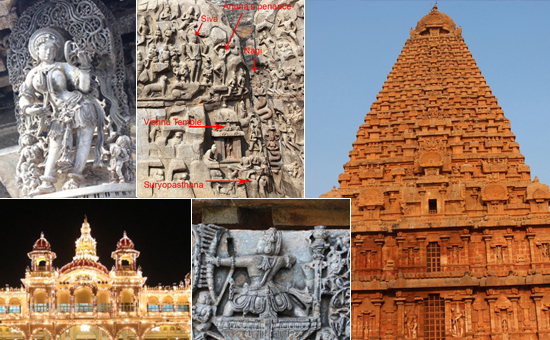 There is more
to India than the Taj-South.
There is more
to India than the Taj-South.
Akbar ‘The Great’
Historians
who refuse to see the pre-Akbar period of Muslim rule as a nightmare for Hindus
paradoxically hail Akbar as a dazzling dawn for the same Hindus. Akbar
abolished the pilgrim tax and the jizyah; he appointed Hindus to high positions, and he extended certain concessions to Hindus. However, if these discriminatory taxes and disabilities did not exist earlier, how did Akbar free Hindus from them? Akbar has become ‘The Great’ thanks to some major image building by Nehru and other historians.
Many Muslim historians, theologians, and Maulana Abul Azad accuse Akbar of jeopardising Islam by tempering with the established tenets of Muslim polity. Maulana Abul Kalam Azad has written that if Ahmad Sirhindi had not come to the rescue, Akbar had almost finished Islam in India. Only in post-independent India, secularist Muslim historians started presenting Akbar as a ‘secular hero’ for Hindu consumption.
The
original sources tell a different story of Akbar:
1. There was nothing Indian about Akbar except that he lived his life in India. He knew nothing about India’s spiritual traditions, history, and culture.
2. Akbar conquered a large part
of India mainly on the strength of Muslim swordsmen imported from Central Asia
and Persia. He proudly considered himself a descendent of Taimur and Babur and
longed to recover the homel ands of his ancestors in Transoxiana.
3. He continued to decorate his
name with the Islamic honorific ghazi acquired after beheading the half-dead Himu. The wars against the only resistant Hindu kingdoms – Mewar and Gondwana – had all the characteristics of classic jihad. He would frequently seek blessings from
the dargah of Moinuddin Chishti.
4. He sent rich gifts to many
centres of Muslim pilgrimage including Mecca and Medina, and carried on
negotiations with the Portuguese for the safe voyage of Muslim pilgrims.
In his letters to the Sharifs of Mecca, he protested that he was not only
a good Muslim but also a champion of Islam and that the orthodox Ulama who
harboured doubts about him did not understand his game of consolidating a
strong and durable Islamic empire in India.
5. The concessions were not by
any benevolence but to win Hindu support in his fight with two inveterate foes
of every Muslim empire-builder- the Muslim chieftains and the die-hard
Ulama. He fixed the Muslim chieftains with the help of Rajput princes.
Friendliness towards jogis, Jain munis, and Christian missionaries was to frighten
the Ulama. Akbar remained a prisoner of Islamic thought categories to the end.
6. Akbar strategically used the
Rajputs to consolidate his empire in exchange for a few gestures, ominous to
orthodox Islam in short term but to its advantage eventually. The loss suffered
by the Islamic state due to the abolition of the pilgrim tax and the jizyah was more than compensated with a
streamlined revenue system extracted from the Hindu masses, particularly the
peasantry. It financed the cost of consolidating the empire, maintaining Mughal
pomp, and building monuments.
7. Muslim adventurers from many Islamic countries abroad started flocking towards India on an unprecedented scale during Akbar’s reign. They occupied all the top positions in the army as well as the administration of the Mughal empire.
Akbar’s camouflage did consolidate an Islamic imperial power not known previously. However, this foundation laid the basis for the cruel deeds of Jahangir, Shah Jahan, and Aurangzeb. Far from being a dazzling dawn, Akbar was only the beginning of a darker night which continues till today in the form of Nehruvian Secularism.
First published in www.pragyata.com
and Here
Author is a Neonatal and Paediatrician Surgeon based in Warangal.